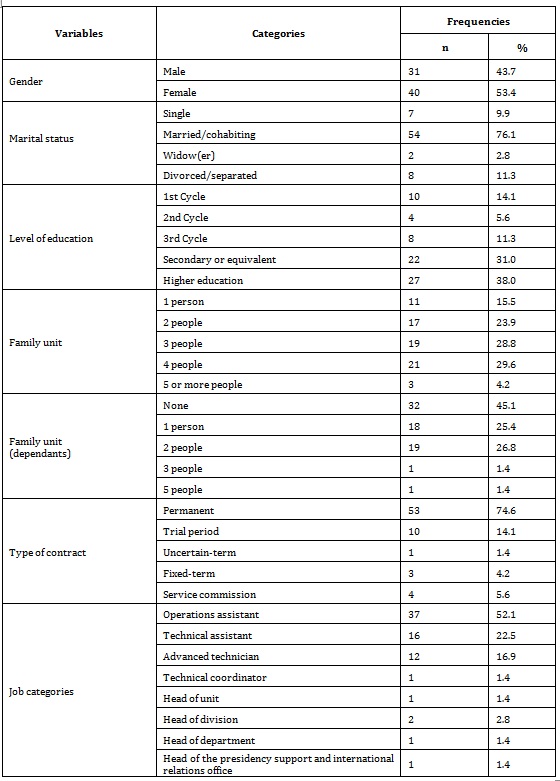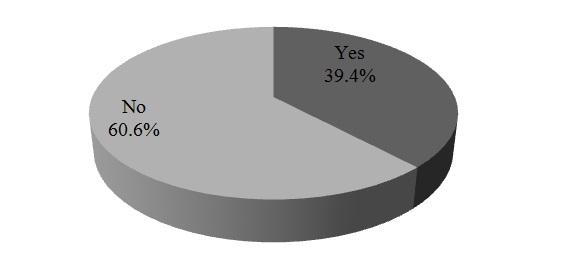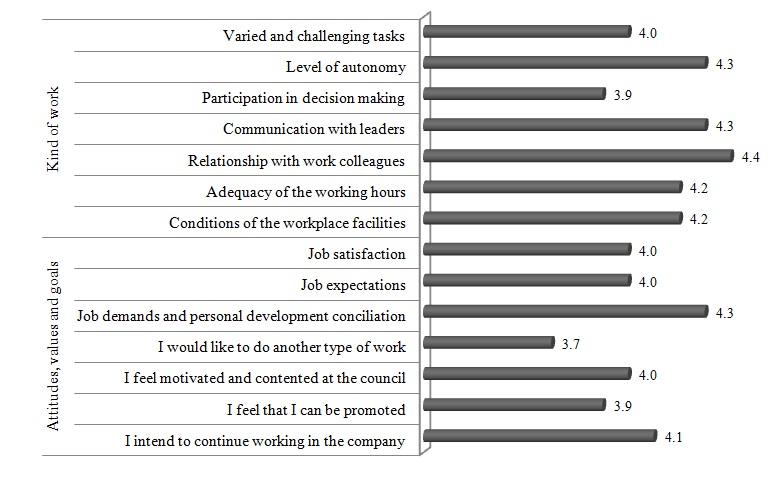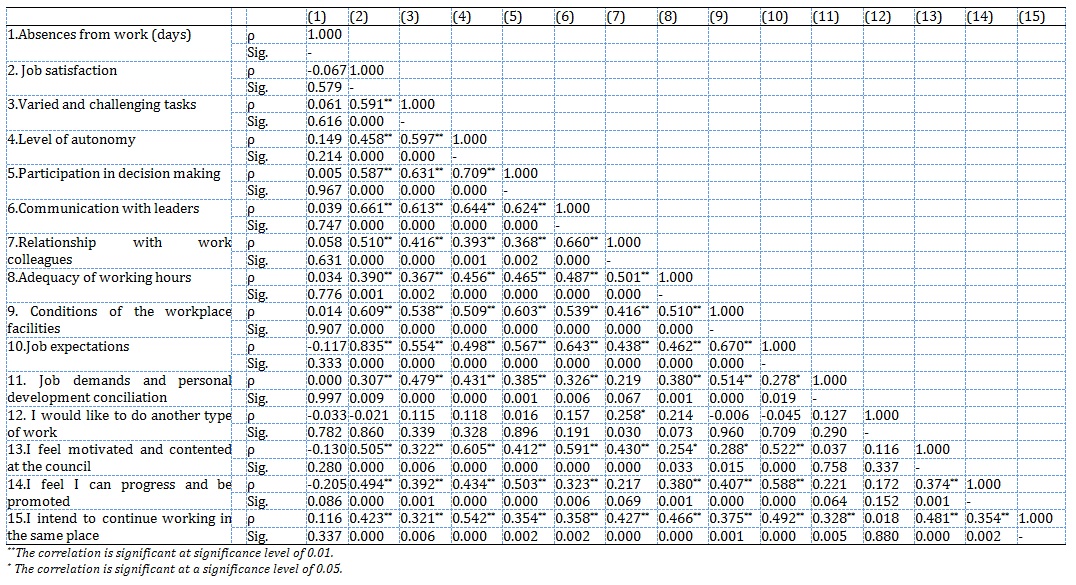Introduction
Municipalities are public entities with a duty to incorporate in their staff technicians who can meet their population’s needs regarding several areas of intervention such as urban planning and management, water supply, basic sanitation, hygiene and cleanness, outdoor spaces, civil protection, fairs and other events organisation, municipal inspection, and human resources (Anselmo, 2010).
Absences from work hinder the organisations’ capacity to execute and complete their tasks satisfactorily, thus, hindering their responsiveness in meeting citizens’ needs. Absenteeism is understood as the lack of physical presence in a certain workplace and at a certain moment when there is a social expectation for the worker to be there (Drakopoulos and Grimani, 2011; Lokke et al, 2007; OIT, 1991). Absenteeism in the workplace has been widely reported as a serious problem, both in developed and in developing countries and in all areas of intervention, which has a negative impact on the labour output dynamics, causing a shortage of staff and consequently, a quantitative and qualitative decrease in productivity (Cooper and Dewe, 2008; OTI, 1991).
Murcho and Jesus (2014), retrieve the concept of Sancinetti et al (2011) by claiming that «work absenteeism is a reflection of the failure of workers’ socialisation as members of their companies, or a defence mechanism against the pressures exerted», which places this phenomenon in the field of social skills and adaptability. But this is not all; the truth is that absenteeism has financial consequences, causing added costs related to the absent workers themselves (benefits, salaries) as well as costs associated with managing the problems caused by absenteeism (Cooper and Dewe, 2008).
The literature on this topic suggests that absence from work is a complex issue, influenced by multiple causes, both personal and organisational (Drakopoulos and Grimani, 2011; Yianiv, 1995). The causes are generally multifaceted and are influenced not only by the individuals’ health condition, but also by the social security system, the work environment, biological factors, attitudes and commitment towards work, macro-economic conditions, among other social and psychological factors (Brown and Sessions 1996; Drakopoulos and Grimani, 2011; Yianiv, 1995). Some of the factors more frequently reported to be responsible for absenteeism are: health problems; environmental factors (distance from work, transport issues, relationship with managing consequent problems and replacement of the absent workers); and individual behaviours (commitment to work, personal lifestyle like drinking or drug abuse).
Murcho and Jesus (2014) observed that this phenomenon was multifaceted and that its contributing factors would be the dissatisfaction towards the organisation of services, the need to look after or support their children, the lack of professional recognition by others (other professionals, clients, patients, etc.), stress, anxiety and tiredness, the need for continuous/post-graduate training, problems with colleagues or headships, work overload, occupational accidents/illnesses, the need to solve unavoidable personal/family bureaucratic matters (taxes, bank, school, etc.), shift work, distaste for the duties performed, the impossibility to do leisure activities that cannot be fulfilled during holidays or time off, bad working environment, demotivation, and personal sickness, accidents or other health issues. Such factors may vary from organisation to organisation (Mgonja, 2017). One important factor related to workers’ absenteeism is their job satisfaction (George and Jones 2007; Steers and Rhodes, 1978); that is, professionals with a higher job satisfaction are less likely to be absent from work (Drakopoulos and Grimani, 2011; Lokke, 2007; Poongavanam, 2017).
Several authors argue that job satisfaction is positively correlated with organizational commitment and negatively correlated with the level of absenteeism (Edwards, 2014; Ibrahim and Aslinda, 2013; Koning and Van Kleef, 2015; Pavalache-Ilie, 2014). Scott and Mabes (1984) argue that although absenteeism may be caused by the employee’s inability to work, motivation for work determines the absenteeism rate. According to Araujo (2011), absenteeism is directly related to the attitudes of the individual and their own identity in relation to work. Siu (2002) maintains that job satisfaction is a good predictor of absenteeism. Hoque and Islam (2003) concluded that, as a rule, workers who feel less rewarded or recognized exhibit lower levels of performance and satisfaction and greater absenteeism. However, in the literature, there is no consensus on this issue (Drakopoulos and Grimani, 2013). Several studies suggest that there is no relationship between job satisfaction and absenteeism (Goldberg and Waldman, 2000) and others argue that the relationship is very fragile (Lau et al., 2003). In this context, this research aims to present the preliminary results on work absenteeism in the Municipality of Bragança, Portugal; to analyze the correlation between absenteeism and job satisfaction, and to identify factors related to the type of work as well as workers’ attitudes, behaviors and values, associated with job satisfaction.
Methods
This research consists of a quantitative, analytical, observational and cross-sectional study developed between April 2018 and July 2018 in the medium-sized municipality of Bragança, located in the northeast of Portugal. During the study’s time window, the organisation staff was composed of 361 workers, among whom 356 were permanent staff and 5 had a different contract situation. The permanent staff workers were distributed as follows: 40 advanced technicians; 4 IT technicians; 79 technical assistants; 211 operations assistants, and 5 were in subsisting careers (Relatório e Contas do Município de Bragança, 2017). In 2017, the absenteeism rate in Bragança municipality was 8.5%, which is lower than the mean of the Municipalities of the North of Portugal (10%). After analysis, it was found that short and long-term sickness were the main causes for the employees’ absence from work, accounting for about 41.3% of the total absenteeism (Relatório e Contas do Município de Bragança, 2017).
The sample collected so far was chosen randomly and is composed of 71 workers of Bragança Municipality. For the data collection, a survey made up of 4 sections was used. The first section included socio-economic variables which enabled the characterisation of the respondents; the second one focused on questions about the job; the third one involved questions related to absenteeism; finally, the fourth section was composed of 14 statements concerning attitudes and values associated with the job. In order to respond to these statements, the surveyed were asked to answer by using a Likert scale ranging from 1 (not important) to 5 (very important). The data analysis was conducted by using the program IBM SPSS version 24. Besides the descriptive statistics procedures, the data analysis also involved Spearman’s correlation test calculations, with a level of significance of 5%. The present study was authorised by the Chief Executive of Bragança Municipality. The anonymity and confidentiality of the answers were granted to all participants.
Results
Sociodemographic and Professional Characterisation
The sample was composed of workers with ages ranging between 25 and 68 years old. The age mean was 49.9 (SD = 10.2). As presented in Table 1, the majority of the respondents were female (53.4%), married or cohabiting (76.1%), living in family units composed of 2 or 3 people (66.2%) with 1 or 2 dependants (52.2%), and with qualifications of secondary (31.0%) or higher education (38.0%) levels. As far as their professional situation is concerned, the majority had a permanent contract (74.6%), in the job category of operations assistant (52.1%) (Table 1). The length of service varied between 6 months and 48 years, with a mean of 21.4 (SD = 12.2).
Table 1: Workers’ Sociodemographic and professional characterisation (n=71)

Attitudes, values and goals towards the job
As shown in Fig 1, 39.4% of the workers were at some point absent from work over the last 12 months.
The reasons given by the workers to justify their absence were as follows: short-term sickness (14.1%), family care giving and support (12.7%), long-term sickness (7.0%), other reasons (8.5%), namely civic activities, medical appointments, compliance with court rules, surgery, and being a working-student. In terms of time, the absences accounted for ranged from 1 to 90 days. Considering the whole of the sample, the mean of the number of absences was 4.8 days (SD=15.4). Among the workers who had been absent from work, the mean of the number of absences was 12 days (SD=22.9). The median and the mode were 4 and 2 days, respectively. The total sum of absences from work was 340 days.

Fig. 1: Absenteeism over the last 12 months
The characteristics associated with the type of work which were most valued by workers were the “relationship with colleagues” ( =4.4), the “level of autonomy” ( =4.3) and the “communication with leaders” ( =4.3). With regard to attitudes, values and goals, the following factors were considered important or very important by workers to perform a good job and respond efficiently to the population needs: “conditions of the workplace facilities” ( =4.2); “adequacy of the working hours” ( =4.2); “being motivated and contented at the municipality” ( =4.1); “job expectations” ( =4.0); “job satisfaction” ( =4); and the possibility to “continue working in the same place and organisation” ( =4.0) (Fig 2).

Fig. 2: Means of the characteristics regarding the type of work and workers’ attitudes, values and goals
The results of Spearman’s test indicate the existence of correlations statistically significant, positive and moderate between the several characteristics regarding the type of work. The correlations worth highlighting are the “communication with leaders” with the items “Relationship with work colleagues” (ρ = 0.660; Sig. = 0.000), “level of autonomy” (ρ = 0.644; Sig. = 0.000) and “participation in decision making” (ρ = 0.624; Sig. = 0.000), corresponding to the characteristics which were most valued by the workers. Also, the data did not allow proving the existence of a correlation between the type of work and absenteeism (Table 2).
The job satisfaction presented correlations varying from moderate to high with the items “job expectations” (ρ = 0.505; Sig. = 0.000), “I feel I can progress and be promoted” (ρ = 0.494; Sig. = 0.000), “I intend to continue working in the same place” (ρ = 0.423; Sig. = 0.000) and “work demands and personal development conciliation” (ρ = 0.307; Sig. = 0.009). On the other hand, no statistically significant correlation was found between job satisfaction and absenteeism (ρ = -0.067; Sig. = 0.579) (Table 2).
As far as workers’ attitudes, behaviours and goals are concerned, positive correlations were found between job satisfaction and the items “job expectations” (ρ = 0.835; Sig. = 0.000), “job demands and personal development conciliation” (ρ = 0.307; Sig. = 0.009), “I feel motivated and contented at the council” (ρ = 0.505; Sig. = 0.000), “I feel I can progress and be promoted” (ρ = 0.494; Sig. = 0.000), and “I intend to continue working in the company” (ρ = 0.423; Sig. = 0.000) (Table 2).
Table 2: Correlation between absenteeism and the type of work and workers’ attitudes, values and goals

Discussion and Conclusion
This research presents the preliminary results of a cross-sectional study on absenteeism which is being conducted in small and medium-sized municipalities located in the northeast of Portugal. The present study aimed to analyse the correlation between absenteeism and job satisfaction. It was conducted with a sample composed of 71 workers of Bragança Town Council, who were, in their majority, female with ages ranging from 26 to 68 years old.
The characteristic associated with the type of work which was most valued by the workers is the “relationship with work colleagues”, which is consistent with the results found by Baía and Ramos (2017) in a study developed in the municipality of Moimenta da Beira, Viseu, Portugal.
Contrary to expectations, the results of the present study showed that job satisfaction and absenteeism are not correlated. Also, the study shows the existence of moderate correlations between job satisfaction and the type of work, as well as between job satisfaction and workers’ attitudes, values and goals, namely “job expectations”, “I feel motivated and contented at the council”, “I feel I can progress and be promoted”, “I intend to continue working in the same place”, and “job demands and personal development conciliation”. Contented workers have higher motivation and expectations towards their job, reporting a higher involvement in the work and a higher commitment towards the organisation. Similar results were found by Mashonganyika (2004), Blau and Boal (1987), Hanisch and Hulin (1991), Zboril-Benson (2002), and Abdallah, Obeidat, Aqqad, Janini and Dahiyat (2017) in different countries, cultural contexts, sectors of economic activity and types of organizations. These authors claim that absenteeism reflects “invisible” attitudes such as job dissatisfaction, low involvement in the work, low level of organisational commitment or an intention to resign. According to these authors, the workers who claim to be contented with their job feel strongly involved and committed to the job and the organisation. Therefore, they will avoid being absent from work at all costs. In a meta-analysis conducted by McShane (1984), the author concluded that there were few studies reporting a correlation between absenteeism and job satisfaction. However, such studies gave evidence that workers dissatisfied with several aspects related to their job, namely general job dissatisfaction, dissatisfaction towards co-workers, salary and leaderships, were more likely to be absent from work. Only the satisfaction regarding promotions did not show to be correlated to absenteeism. Also, Drakopoulos and Grimani (2013) argued that despite the lack of a universal agreement in literature regarding the association between absenteeism and job satisfaction, the latter is a complex issue, influenced by multiple causes, both personal and organisational, thus affecting workers’ motivation and performance. Furthermore, Susanto (2017) considers that job satisfaction can reduce absenteeism and improve workers’ performance both directly and indirectly. To sum up, if on the one hand, it is believed that absence from work is somehow a natural consequence of job dissatisfaction, there are those who, on the other hand, defend the non-existence of an association between job satisfaction and absenteeism, arguing that absence from work is the result of behaviours influenced by a diversity of factors.
Note that the conclusions of this research are based on preliminary results and therefore, although the sample is random, it is not representative, which means that the results cannot be generalised to the population under study. Despite this, the conclusions drawn here will always be valid for the group of workers surveyed. Another limitation is related to the fact that this study is cross-sectional, which makes it a static study. Nevertheless, such constraint can be mitigated in future research works allowing monitoring the evolution of absenteeism in Portuguese municipalities.
Although preliminary and with limitations, the results may allow reducing the absenteeism in the Municipality of Bragança by improving the motivation of workers. Thus, promoting team work that value relationships with colleagues, increasing the autonomy at the workplace and involving workers in the decision making process are motivation factors that could be used to reduce the absenteeism.
Acknowledgements
This work is supported by: the European Structural and Investment Funds in the FEDER component, through the Operational Competitiveness and Internationalisation Programme (COMPETE 2020) [Project No. 006971 (UID/SOC/04011)]; and national funds, through the FCT – Portuguese Foundation for Science and Technology under the project UID/SOC/04011/2013.
(adsbygoogle = window.adsbygoogle || []).push({});
References
- Abdallah, A. B., Obeidat, A. Y., Aqqad, O., Al Janini, M.N.K., and Dahiyat S. E. (2016). An Integrated Model of Job Involvement, Job Satisfaction and Organizational Commitment: A Structural Analysis in Jordan’s Banking Sector Communications and Network, 9, 28-53.
- Anselmo, R. (2010). A Segurança, Higiene e Saúde no Trabalho nas Autarquias do Baixo Alentejo e Alentejo Litoral. In Investigação e Intervenção em Recursos Humanos 2010 – Dilemas de uma sociedade em transformação. Escola Superior de Ciências Empresariais do Instituto Politécnico de Setúbal 23 e 24 de Setembro de 2010.
- Araújo, E.R. (2011). Sistema de Registo Biométrico no Controlo da Assiduidade e da Pontualidade: Estudo de Caso no Hospital do SNS. Dissertação de Mestrado em Gestão ad Saúde, Escola Superior da Saúde Pública. Universidade Nova de Lisboa.
- Baía, A. and Ramos, C. (2017). Absenteeism: Moibe Municipality – Portugal, International Journal of Business and Management Studies, 6 (2), 335-350.
- Blau, G. and Boal, K. (1987) Conceptualizing How Job Involvement and Organizational Commitment Affect Turnover and Absenteeism. Academy of Management Review, 12, 288-300.
- Brown, S. and Sessions, J.G. (1996). The economics of absence: Theory and evidence, Journal of Economic Surveys, 10 (1), 23-53.
- Cooper C, and Dewe P. (2008). Well-being: absenteeism, presenteeism, costs and challenges. Occupational Med [Internet]. [cited 2018 Jun 10]; 58:522-4. Available from: http://occmed.oxfordjournals.org/content/58/8/522.long.
- Drakopoulos , A. A. and Grimani, K. (2013). Injury-related absenteeism and job satisfaction: insights from Greek and UK data. The International Journal of Human Resource Management, 24 (18), 3496-3511.
- Drakopoulos, S. and Grimani, A. (2011). The relationship between absence from work and job satisfaction: Greece and UK comparisons. MPRA Paper No. 30990, posted 19. May 2011 19: 27 UTC. University of Athens.
- Edwards, V. L. (2014). Examining absenteeism in the public and non-profit sectors. International Journal of Organization Theory and Behavior, 17 (3), 293-310.
- George, J.M., and Jones, G.R. (2007). Understanding and managing organizational behavior. New Jersey : Prentice Hall.
- Goldberg, C. B. and Waldmn, D. A. (2000). Modelling employee absenteeism: testing alternative measures and mediated effects based on job satisfaction, Journal of Organizational Behavior, 21, 665-676.
- Hackett, R.D. and Guion, R.M. (1985). A reevaluation of the absenteeism-job satisfaction relationship. Organ Behav Hum Decis Process, 35 (3), 340-81.
- Hanisch, K.A. and Hulin, C.L. (1991). General attitudes and organizational withdrawal: An evaluation of a causal model. Journal of Vocational Behavior, 39 (1): 110-128.
- Harrison, D.A. and Hulin, C.L. (1989). Investigations of absenteeism: Using event history models to study the absence-taking process. Journal of Applied Psychology, 74, 300- 306.
- Hoque, E and Islam, M. (2003). Contribution of some behavioural factors to absenteeism of manufacturing in Bangladesh, Pakistan Journal of Psychological Research, 18: 81-96.
- Ibrahim, M.A. and Aslinda, A. (2013). Relationship between organizational commitment and organizational citizenship behavior at government-owned corporation companies. Journal of Public Administration and Governance, 3 (3), 35-42.
- Koning, L.F. and Van Kleef, G.A. (2015). Howleaders’ emotional displays shape followers’ organizational citizenship behavior, The Leadership Quarterly, 26, 489–501.
- Lau, V.C.S., Au, W.T. and Ho, J.M.C. (2003). A qualitative and quantitative review of antecedents of counterproductive behaviour in organizations, Journal of Business and Psychology, 18 (1), 73-98.
- Lokke, A-K., Eskildsen, J. and Jensen, T., (2007). Absenteeism in the Nordic Countries, Employee Relations, 29 (1), 16-29.
- Mashonganyika, O. (2004). The relationship between job satisfaction and absenteeism : a study of the shop floor workers in a motor manufacturing plant. MBA, Faculty of Commerce, Rhodes Investec Business School. Rhodes University, South Africa.
- McShane, S.L. (1984). Job Satisfaction and Absenteeism A Meta-Analytic Reexamination Canadian, Journal of Administrative Sciences, 1 (1), 61-77.
- Mgonja, M. (2017). Responding to Workplace Absenteeism in Tanzania: The case study of Public and Private Schools in Ilala Municipality and Mkuranga District. International Journal of Educational Leadership and Management, 5 (1), 85-108. Doi: 10.17583/ijelm.2017.2341.
- Município de Bragança (abril 2018). Relatório e contas 2017. Bragança.
- Murcho, N. A. C. and Jesus, S. N. (2014). Absenteísmo no trabalho. In M. M. M. Siqueira (Org.). Novas medidas do comportamento organizacional: ferramentas de diagnóstico e de gestão (pp. 15-24). Porto Alegre: Artmed.
- OIT (Oficina Internacional Del Trabajo). (1991). Enciclopedia de Salud, Seguridad e Higiene em el trabajo. Espana: Centro de Publicaciones del Ministerio de Trabajo Y Seguridad Social, 1, 5-11.
- Pavalache-Iliea, M. (2014). Organizational citizenship behaviour, work satisfaction and employees’ personality. Procedia: Social and Behavioral Sciences, 127, 489 – 493.
- Poongavanam, S. (2017). Employee absenteeism – A case study of leather firm in vellore, International Journal of Research in Social Sciences, 7 (10), 7-21.
- Scott, K.D. and Mabes, D.A. (1984). The Job Satisfaction/Absenteeism Relationship: Gender as a Moderating Variable, Akron Business and Economic Review, 43-47.
- Siu, O. (2002). Predictors of job satisfaction and absenteeism in two samples of Hong Kong nurses, Journal of Advanced Nursing, 40 (2), 218-229.
- Steers, R., and Rhodes, S. (1978). Major influences on employee attendance: A process model. Journal of Applied Psychology, 63, 391-407.
- Susanto, A. B. (2017). Job Satisfaction and Absenteeism on the Performance of Lecturer in Private Higher Education in Semarang, GATR Journals jmmr134, Global Academy of Training and Research (GATR) Enterprise.
- Yianiv, G. (1995). Burnout, absenteeism, and the overtime decision, Journal of Economic Psychology, 16, 297-309.
- Zboril-Benson, L. R. (2002). Why nurses are calling in sick: the impact of health-care restructuring. Can J Nurs Res., 33 (4), 89-107.







